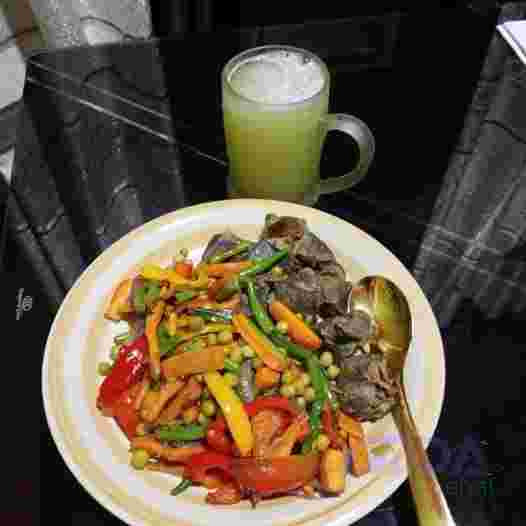PRESS RELEASE
How Makinde's agriculture policies brought about innovations, food security in Oyo - Commissioner
Oyo State's Commissioner for Agriculture and Rural Development, Barr. Olasunkanmi Olaleye has stated that the policies of Governor 'Seyi Makinde towards improving the agriculture sector have worked well in bringing about necessary reforms and innovations in agriculture practice in the state.
He maintained that through the combination of technical services, infrastructure development and investments in human capital in the sector, the state has become a leader in agricultural innovations and food security in Nigeria.
Olaleye, who stated this on Thursday, at the opening session of an inter-ministerial press briefing organised by Governor Makinde's Media Unit, to commemorate the second anniversary of Omituntun 2.0, highlighted the achievements of his Ministry.
Olaleye noted that through these veterinary services, rural development, extension services, capacity building and infrastructure development programmes carried out by the Ministry, the state has emerged as a leading agricultural hub in Nigeria.
He pointed out the example of the impact being made by the Fasola Agribusiness Industrial Hub in the areas of attracting investments and becoming a model for other states of the federation and a point of attraction for the African Development Bank (AfDB) and other financial institutions for partnership.
He declared that through different efforts and policies implemented by the governor, the Ministry of Agriculture has successfully nurtured farmers and improved food production.
He added that the administration has also built the infrastructure and institutional capacity needed for sustainable agricultural growth in the state, such as the establishment of nine Farm Service Centres across the agricultural zones statewide and the renovation of eight strategic facilities across the state.
Olaleye said: "Under the governor's progressive leadership and his administration's dedication to agricultural excellence, our Ministry has recorded unprecedented successes across all sectors of agricultural development."
The governor's policy direction, financial support, and political will have created an enabling environment that has allowed us to implement transformative programmes that are directly impacting the lives of our farmers and rural communities.
"I wish to express our profound appreciation to His Excellency for his consistent support and to acknowledge the collective efforts of our dedicated staff, development partners, farmers, and all stakeholders whose collaboration has made these achievements possible."
The successes we celebrate today are a testament to what is achievable when leadership vision meets professional dedication and community participation.
“This report highlights our key accomplishments across veterinary services, rural development, extension services, capacity building, and infrastructure development - all contributing to Oyo State's emergence as a leading agricultural hub in Nigeria.”
“Our veterinary services have demonstrated exceptional commitment to livestock health protection through our strategic vaccination programme. We have successfully vaccinated 95,948 cattle against Anthrax and Contagious Bovine Pleuropneumonia (CBPP), representing 80 per cent progress toward our ambitious target of 120,000 cattle.”
“This proactive approach has significantly reduced livestock mortality rates and protected farmers' investments while safeguarding public health through the prevention of zoonotic diseases.”
“In terms of regulatory framework, we have strengthened the agricultural sector through the development of crucial regulatory frameworks, including comprehensive guidelines and regulations for hatchery operations in Oyo State, standard operating procedures for poultry processors, and the Oyo State Trade Cattle, Sheep and Goats Law with detailed SOPs for livestock dealers.”
"These regulations provide clear operational standards that enhance productivity while ensuring animal welfare and consumer protection.”
“In the area of rural development, our rural infrastructure development programme continues to transform agricultural communities through strategic road construction projects totalling 87.53 kilometres across multiple local governments.”
“These include the FRSC-Okudi-Oyada road: 6.82 km in ATISBO LG; 4.37 km Market-Illa junction in Oriire LG; 8.85 km Adebayo Alata-Obembe, Aba Oje Road in Oluyole LG; 21.96 km Oloko-Oyo-Ikere Gorge Dam Road in Iseyin LG; 8.43 km Fasola Farm Settlement Road in Oyo West LG and the 37.1 km Alako-Idi-Iya-Batake-Olowa Farm Settlement Road.”
Explaining further, Olaleye noted that the government's agriculture mechanisation support programme has also seen it plough 13,077.10 acres for 2,827 farmers as of June 10th, 2025 under the Tractorisation Subsidy Programme.
“Our mechanisation support programme has achieved remarkable success, with 1,487 farmers benefiting from 50 per cent tractorisation subsidies in 2024, resulting in 6,090 acres of farmland being ploughed.”
The momentum continues into 2025, with 13,077.10 acres already ploughed for 2,827 farmers as of June 10th, 2025, as we work toward our ambitious target of 120,000 acres for the year.
“In the area of extension services, we provided 15 motorcycles to Extension Officers, dramatically improving their ability to reach farmers in remote areas.
Additionally, we conducted comprehensive training for both farmers and Extension Officers on the 2025 Seasonal Climate Prediction by the Nigerian Meteorological Agency, ensuring climate-informed agricultural decision-making.”
“We have also significantly strengthened our technical capacity through the recruitment of 20 veterinary doctors and 141 agricultural officers across various cadres, ensuring adequate professional support for our expanding programs and services.”
“In the area of input distribution to support agriculture enterprises, our comprehensive input distribution programme reached thousands of farmers: soybean seeds to 920 farmers, maize seeds to 3,541 farmers, cassava stems to 1,269 farmers (covering 47,587.5 acres with potential to produce 214,143.75 tons of cassava tubers), knapsack sprayers to 1,980 farmers, and herbicides and pesticides to 2,500 farmers.”
“We distributed quality inputs to diverse livestock farmers: 1,150 fish farmers received 3 bags each of 15kg quality fish feed; 2,536 cattle, sheep, and goat farmers received nutritional supplements including 253,600kg of wheat offal, brewery dried grains, salt licks, and disinfectants; 3,740 poultry farmers received 8 bags of 50kg maize grains each; and 1,028 pig farmers received palm kernel cake and disinfectants.”
“Our massive distribution of 65,000 bundles of cassava stems to 1,269 farmers demonstrates our commitment to food security, with projections showing potential production of 214,143.75 tons of cassava tubers from 47,587.5 acres of newly planted farmland.”
"We provided microloans to 3,501 smallholder farmers with soft loans ranging from ₦50,000 to ₦800,000 per beneficiary, enabling farmers to expand their operations and improve their livelihoods.”
"Our capacity-building initiatives reached 3,830 individuals across various agricultural enterprises:
"We also trained 62 rural farmers in modern agricultural practices at the Oyo State-IITA Youth Agribusiness Incubation Centre in Aawe, providing them with both knowledge and land allocation for practical application.”
"In conclusion, these achievements represent a comprehensive approach to agricultural development that addresses every aspect of the value chain - from input supply and production support to processing, marketing, and capacity building.”
"Our programmes have directly impacted tens of thousands of farmers while building the infrastructure and institutional capacity needed for sustainable agricultural growth in Oyo State. The combination of technical services, infrastructure development, and human capital investment positions our state as a leader in agricultural innovation and food security in Nigeria."
Earlier, the Secretary to the State Government, Prof. Olanike Adeyemo, who declared the session open, appreciated the people of the state and the media for their support for Governor Makinde's administration since its inception.
She assured that the government would continue to prioritise and serve the interests of the people.
Also in his welcome address, the Special Adviser on Media to the governor, who also doubles as the Chief Press Secretary, Dr Sulaimon Olanrewaju, said the inter-ministerial press briefing was organised to enable Commissioners and Heads of Government Departments and Agencies give account of their activities in the last two years and to explain how the efforts have impacted on the lives of the citizens.
Signed
Dr Sulaimon Olanrewaju
Special Adviser (Media) to Oyo State Governor
June 19, 2025.
How Makinde's agriculture policies brought about innovations, food security in Oyo - Commissioner
Oyo State's Commissioner for Agriculture and Rural Development, Barr. Olasunkanmi Olaleye has stated that the policies of Governor 'Seyi Makinde towards improving the agriculture sector have worked well in bringing about necessary reforms and innovations in agriculture practice in the state.
He maintained that through the combination of technical services, infrastructure development and investments in human capital in the sector, the state has become a leader in agricultural innovations and food security in Nigeria.
Olaleye, who stated this on Thursday, at the opening session of an inter-ministerial press briefing organised by Governor Makinde's Media Unit, to commemorate the second anniversary of Omituntun 2.0, highlighted the achievements of his Ministry.
Olaleye noted that through these veterinary services, rural development, extension services, capacity building and infrastructure development programmes carried out by the Ministry, the state has emerged as a leading agricultural hub in Nigeria.
He pointed out the example of the impact being made by the Fasola Agribusiness Industrial Hub in the areas of attracting investments and becoming a model for other states of the federation and a point of attraction for the African Development Bank (AfDB) and other financial institutions for partnership.
He declared that through different efforts and policies implemented by the governor, the Ministry of Agriculture has successfully nurtured farmers and improved food production.
He added that the administration has also built the infrastructure and institutional capacity needed for sustainable agricultural growth in the state, such as the establishment of nine Farm Service Centres across the agricultural zones statewide and the renovation of eight strategic facilities across the state.
Olaleye said: "Under the governor's progressive leadership and his administration's dedication to agricultural excellence, our Ministry has recorded unprecedented successes across all sectors of agricultural development."
The governor's policy direction, financial support, and political will have created an enabling environment that has allowed us to implement transformative programmes that are directly impacting the lives of our farmers and rural communities.
"I wish to express our profound appreciation to His Excellency for his consistent support and to acknowledge the collective efforts of our dedicated staff, development partners, farmers, and all stakeholders whose collaboration has made these achievements possible."
The successes we celebrate today are a testament to what is achievable when leadership vision meets professional dedication and community participation.
“This report highlights our key accomplishments across veterinary services, rural development, extension services, capacity building, and infrastructure development - all contributing to Oyo State's emergence as a leading agricultural hub in Nigeria.”
“Our veterinary services have demonstrated exceptional commitment to livestock health protection through our strategic vaccination programme. We have successfully vaccinated 95,948 cattle against Anthrax and Contagious Bovine Pleuropneumonia (CBPP), representing 80 per cent progress toward our ambitious target of 120,000 cattle.”
“This proactive approach has significantly reduced livestock mortality rates and protected farmers' investments while safeguarding public health through the prevention of zoonotic diseases.”
“In terms of regulatory framework, we have strengthened the agricultural sector through the development of crucial regulatory frameworks, including comprehensive guidelines and regulations for hatchery operations in Oyo State, standard operating procedures for poultry processors, and the Oyo State Trade Cattle, Sheep and Goats Law with detailed SOPs for livestock dealers.”
"These regulations provide clear operational standards that enhance productivity while ensuring animal welfare and consumer protection.”
“In the area of rural development, our rural infrastructure development programme continues to transform agricultural communities through strategic road construction projects totalling 87.53 kilometres across multiple local governments.”
“These include the FRSC-Okudi-Oyada road: 6.82 km in ATISBO LG; 4.37 km Market-Illa junction in Oriire LG; 8.85 km Adebayo Alata-Obembe, Aba Oje Road in Oluyole LG; 21.96 km Oloko-Oyo-Ikere Gorge Dam Road in Iseyin LG; 8.43 km Fasola Farm Settlement Road in Oyo West LG and the 37.1 km Alako-Idi-Iya-Batake-Olowa Farm Settlement Road.”
Explaining further, Olaleye noted that the government's agriculture mechanisation support programme has also seen it plough 13,077.10 acres for 2,827 farmers as of June 10th, 2025 under the Tractorisation Subsidy Programme.
“Our mechanisation support programme has achieved remarkable success, with 1,487 farmers benefiting from 50 per cent tractorisation subsidies in 2024, resulting in 6,090 acres of farmland being ploughed.”
The momentum continues into 2025, with 13,077.10 acres already ploughed for 2,827 farmers as of June 10th, 2025, as we work toward our ambitious target of 120,000 acres for the year.
“In the area of extension services, we provided 15 motorcycles to Extension Officers, dramatically improving their ability to reach farmers in remote areas.
Additionally, we conducted comprehensive training for both farmers and Extension Officers on the 2025 Seasonal Climate Prediction by the Nigerian Meteorological Agency, ensuring climate-informed agricultural decision-making.”
“We have also significantly strengthened our technical capacity through the recruitment of 20 veterinary doctors and 141 agricultural officers across various cadres, ensuring adequate professional support for our expanding programs and services.”
“In the area of input distribution to support agriculture enterprises, our comprehensive input distribution programme reached thousands of farmers: soybean seeds to 920 farmers, maize seeds to 3,541 farmers, cassava stems to 1,269 farmers (covering 47,587.5 acres with potential to produce 214,143.75 tons of cassava tubers), knapsack sprayers to 1,980 farmers, and herbicides and pesticides to 2,500 farmers.”
“We distributed quality inputs to diverse livestock farmers: 1,150 fish farmers received 3 bags each of 15kg quality fish feed; 2,536 cattle, sheep, and goat farmers received nutritional supplements including 253,600kg of wheat offal, brewery dried grains, salt licks, and disinfectants; 3,740 poultry farmers received 8 bags of 50kg maize grains each; and 1,028 pig farmers received palm kernel cake and disinfectants.”
“Our massive distribution of 65,000 bundles of cassava stems to 1,269 farmers demonstrates our commitment to food security, with projections showing potential production of 214,143.75 tons of cassava tubers from 47,587.5 acres of newly planted farmland.”
"We provided microloans to 3,501 smallholder farmers with soft loans ranging from ₦50,000 to ₦800,000 per beneficiary, enabling farmers to expand their operations and improve their livelihoods.”
"Our capacity-building initiatives reached 3,830 individuals across various agricultural enterprises:
"We also trained 62 rural farmers in modern agricultural practices at the Oyo State-IITA Youth Agribusiness Incubation Centre in Aawe, providing them with both knowledge and land allocation for practical application.”
"In conclusion, these achievements represent a comprehensive approach to agricultural development that addresses every aspect of the value chain - from input supply and production support to processing, marketing, and capacity building.”
"Our programmes have directly impacted tens of thousands of farmers while building the infrastructure and institutional capacity needed for sustainable agricultural growth in Oyo State. The combination of technical services, infrastructure development, and human capital investment positions our state as a leader in agricultural innovation and food security in Nigeria."
Earlier, the Secretary to the State Government, Prof. Olanike Adeyemo, who declared the session open, appreciated the people of the state and the media for their support for Governor Makinde's administration since its inception.
She assured that the government would continue to prioritise and serve the interests of the people.
Also in his welcome address, the Special Adviser on Media to the governor, who also doubles as the Chief Press Secretary, Dr Sulaimon Olanrewaju, said the inter-ministerial press briefing was organised to enable Commissioners and Heads of Government Departments and Agencies give account of their activities in the last two years and to explain how the efforts have impacted on the lives of the citizens.
Signed
Dr Sulaimon Olanrewaju
Special Adviser (Media) to Oyo State Governor
June 19, 2025.
PRESS RELEASE
How Makinde's agriculture policies brought about innovations, food security in Oyo - Commissioner
Oyo State's Commissioner for Agriculture and Rural Development, Barr. Olasunkanmi Olaleye has stated that the policies of Governor 'Seyi Makinde towards improving the agriculture sector have worked well in bringing about necessary reforms and innovations in agriculture practice in the state.
He maintained that through the combination of technical services, infrastructure development and investments in human capital in the sector, the state has become a leader in agricultural innovations and food security in Nigeria.
Olaleye, who stated this on Thursday, at the opening session of an inter-ministerial press briefing organised by Governor Makinde's Media Unit, to commemorate the second anniversary of Omituntun 2.0, highlighted the achievements of his Ministry.
Olaleye noted that through these veterinary services, rural development, extension services, capacity building and infrastructure development programmes carried out by the Ministry, the state has emerged as a leading agricultural hub in Nigeria.
He pointed out the example of the impact being made by the Fasola Agribusiness Industrial Hub in the areas of attracting investments and becoming a model for other states of the federation and a point of attraction for the African Development Bank (AfDB) and other financial institutions for partnership.
He declared that through different efforts and policies implemented by the governor, the Ministry of Agriculture has successfully nurtured farmers and improved food production.
He added that the administration has also built the infrastructure and institutional capacity needed for sustainable agricultural growth in the state, such as the establishment of nine Farm Service Centres across the agricultural zones statewide and the renovation of eight strategic facilities across the state.
Olaleye said: "Under the governor's progressive leadership and his administration's dedication to agricultural excellence, our Ministry has recorded unprecedented successes across all sectors of agricultural development."
The governor's policy direction, financial support, and political will have created an enabling environment that has allowed us to implement transformative programmes that are directly impacting the lives of our farmers and rural communities.
"I wish to express our profound appreciation to His Excellency for his consistent support and to acknowledge the collective efforts of our dedicated staff, development partners, farmers, and all stakeholders whose collaboration has made these achievements possible."
The successes we celebrate today are a testament to what is achievable when leadership vision meets professional dedication and community participation.
“This report highlights our key accomplishments across veterinary services, rural development, extension services, capacity building, and infrastructure development - all contributing to Oyo State's emergence as a leading agricultural hub in Nigeria.”
“Our veterinary services have demonstrated exceptional commitment to livestock health protection through our strategic vaccination programme. We have successfully vaccinated 95,948 cattle against Anthrax and Contagious Bovine Pleuropneumonia (CBPP), representing 80 per cent progress toward our ambitious target of 120,000 cattle.”
“This proactive approach has significantly reduced livestock mortality rates and protected farmers' investments while safeguarding public health through the prevention of zoonotic diseases.”
“In terms of regulatory framework, we have strengthened the agricultural sector through the development of crucial regulatory frameworks, including comprehensive guidelines and regulations for hatchery operations in Oyo State, standard operating procedures for poultry processors, and the Oyo State Trade Cattle, Sheep and Goats Law with detailed SOPs for livestock dealers.”
"These regulations provide clear operational standards that enhance productivity while ensuring animal welfare and consumer protection.”
“In the area of rural development, our rural infrastructure development programme continues to transform agricultural communities through strategic road construction projects totalling 87.53 kilometres across multiple local governments.”
“These include the FRSC-Okudi-Oyada road: 6.82 km in ATISBO LG; 4.37 km Market-Illa junction in Oriire LG; 8.85 km Adebayo Alata-Obembe, Aba Oje Road in Oluyole LG; 21.96 km Oloko-Oyo-Ikere Gorge Dam Road in Iseyin LG; 8.43 km Fasola Farm Settlement Road in Oyo West LG and the 37.1 km Alako-Idi-Iya-Batake-Olowa Farm Settlement Road.”
Explaining further, Olaleye noted that the government's agriculture mechanisation support programme has also seen it plough 13,077.10 acres for 2,827 farmers as of June 10th, 2025 under the Tractorisation Subsidy Programme.
“Our mechanisation support programme has achieved remarkable success, with 1,487 farmers benefiting from 50 per cent tractorisation subsidies in 2024, resulting in 6,090 acres of farmland being ploughed.”
The momentum continues into 2025, with 13,077.10 acres already ploughed for 2,827 farmers as of June 10th, 2025, as we work toward our ambitious target of 120,000 acres for the year.
“In the area of extension services, we provided 15 motorcycles to Extension Officers, dramatically improving their ability to reach farmers in remote areas.
Additionally, we conducted comprehensive training for both farmers and Extension Officers on the 2025 Seasonal Climate Prediction by the Nigerian Meteorological Agency, ensuring climate-informed agricultural decision-making.”
“We have also significantly strengthened our technical capacity through the recruitment of 20 veterinary doctors and 141 agricultural officers across various cadres, ensuring adequate professional support for our expanding programs and services.”
“In the area of input distribution to support agriculture enterprises, our comprehensive input distribution programme reached thousands of farmers: soybean seeds to 920 farmers, maize seeds to 3,541 farmers, cassava stems to 1,269 farmers (covering 47,587.5 acres with potential to produce 214,143.75 tons of cassava tubers), knapsack sprayers to 1,980 farmers, and herbicides and pesticides to 2,500 farmers.”
“We distributed quality inputs to diverse livestock farmers: 1,150 fish farmers received 3 bags each of 15kg quality fish feed; 2,536 cattle, sheep, and goat farmers received nutritional supplements including 253,600kg of wheat offal, brewery dried grains, salt licks, and disinfectants; 3,740 poultry farmers received 8 bags of 50kg maize grains each; and 1,028 pig farmers received palm kernel cake and disinfectants.”
“Our massive distribution of 65,000 bundles of cassava stems to 1,269 farmers demonstrates our commitment to food security, with projections showing potential production of 214,143.75 tons of cassava tubers from 47,587.5 acres of newly planted farmland.”
"We provided microloans to 3,501 smallholder farmers with soft loans ranging from ₦50,000 to ₦800,000 per beneficiary, enabling farmers to expand their operations and improve their livelihoods.”
"Our capacity-building initiatives reached 3,830 individuals across various agricultural enterprises:
"We also trained 62 rural farmers in modern agricultural practices at the Oyo State-IITA Youth Agribusiness Incubation Centre in Aawe, providing them with both knowledge and land allocation for practical application.”
"In conclusion, these achievements represent a comprehensive approach to agricultural development that addresses every aspect of the value chain - from input supply and production support to processing, marketing, and capacity building.”
"Our programmes have directly impacted tens of thousands of farmers while building the infrastructure and institutional capacity needed for sustainable agricultural growth in Oyo State. The combination of technical services, infrastructure development, and human capital investment positions our state as a leader in agricultural innovation and food security in Nigeria."
Earlier, the Secretary to the State Government, Prof. Olanike Adeyemo, who declared the session open, appreciated the people of the state and the media for their support for Governor Makinde's administration since its inception.
She assured that the government would continue to prioritise and serve the interests of the people.
Also in his welcome address, the Special Adviser on Media to the governor, who also doubles as the Chief Press Secretary, Dr Sulaimon Olanrewaju, said the inter-ministerial press briefing was organised to enable Commissioners and Heads of Government Departments and Agencies give account of their activities in the last two years and to explain how the efforts have impacted on the lives of the citizens.
Signed
Dr Sulaimon Olanrewaju
Special Adviser (Media) to Oyo State Governor
June 19, 2025.















